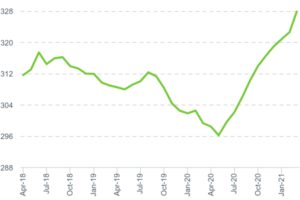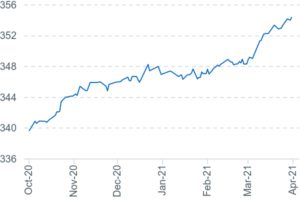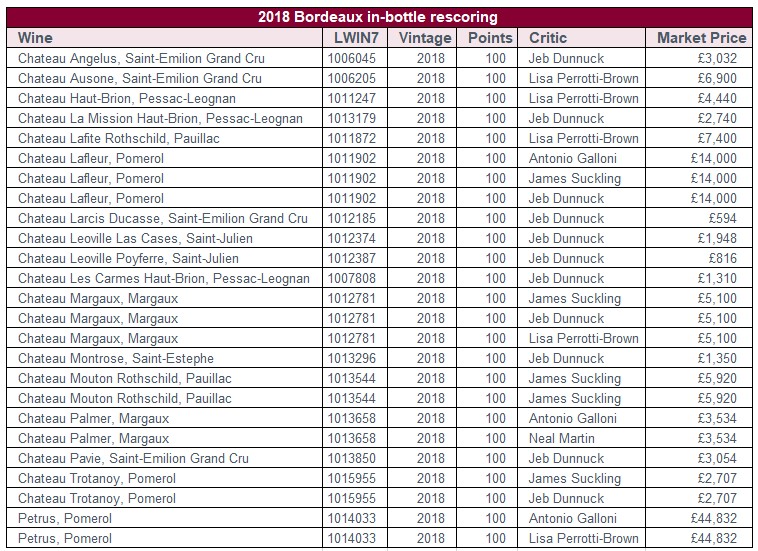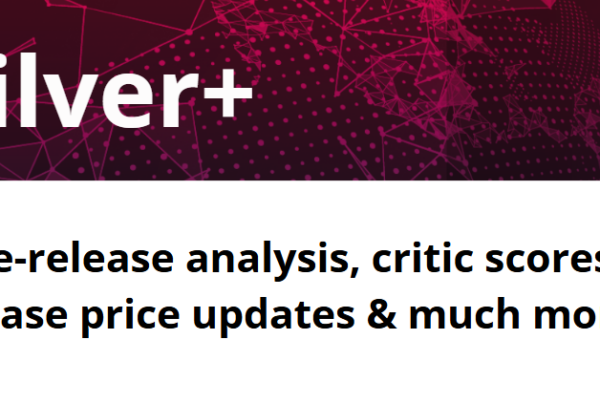Print and read offline instead.
The fine wine market expands in unexpected new directions
- Liv-ex Fine Wine 100 Index
- Liv-ex Fine Wine 50 Index
March was a busy month. It saw various releases from Champagne, Burgundy, Italy and Bordeaux and the important announcement that US trade tariffs on European wine were to be suspended for four months. The following week saw trade increase by 50% in value and 65% in volume, with US buyers particularly active.
This activity was reflected in market share. The Rhône, a region with particularly strong following in the US, was a benefactor, seeing its trade by value from 3.4% in February to 5.1% in March. Burgundy took 23.6% of the market, after its weekly share surpassed that of Bordeaux for the first time ever at the end of the month. Meanwhile, Bordeaux’s share fell (37.2%), despite critical attention surrounding its 2018 vintage as many in-bottle scores were released. Italy held steady at 15.5%, with the USA making further gains (8.1%) and taking a bigger slice of the market than Champagne (7%).
March also surpassed November 2020 as the broadest month of Liv-ex trade on record, after 1,440 distinct wines (LWIN7s) traded on the exchange. When vintage is factored in, a total of 2,711 wines (LWIN11s) changed hands. A Pinot Grigio from Valdadige and Gusbourne’s 2018 Pinot Noir were among the new entrants. Just two years ago, circa 600 wines would trade monthly.
March was also a positive month for prices, with the Liv-ex 100 up 1.6% and the Liv-ex 1000 up 1% (reaching its highest level ever). The Italy 100 was the best performer, up 2.4%, pushed by gains in Tignanello and Solaia.
Major Market Movers – Rhône Revival
Table 1: Best-Performing Rhône labels

The Rhône 100 sub-index broke past the 200 level earlier this year, the last of the Liv-ex 1000 sub-indices to do so. Slow and steady has been the name of the game for the Rhône 100, but of late the index’s performance has picked up momentum; it has seen positive returns in nine of the last 12 months, a 9.94% rise in total.
The index is split 50/50 between wines in the Northern Rhône and wines in the Southern Rhône. The Southern Rhône is leading the gains year-to-date and this continued throughout March. Beaucastel’s Châteauneuf du Pape, Hommage J Perrin 2012, rose 14.5% last month (having dipped in February), the best performance for the whole of the Rhône. From the Northern Rhône, Paul Jaboulet Aîné’s Hermitage Chapelle 2009 rose 13.5%. The region has seen an increase in activity in 2021 – perhaps a pointer to further ahead strength for the region.
Chart of the Month – USA Buying
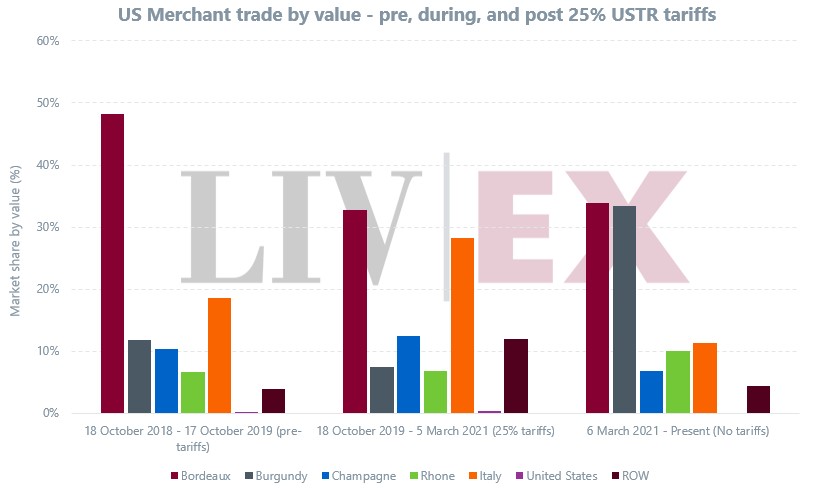
On 5th March, the office of the United States Trade Representative (USTR) and the EU released a joint statement saying there would be a mutual, four-month suspension of the tariffs related to the Airbus-Boeing dispute. This immediately removed the 25% tariffs that had been in place on most EU wines since 18th October 2019.
The tariffs have had an immediate effect on US merchant buying and the broadening of the traditionally smaller regions. Following the original implementation of tariffs, trade in Bordeaux and Burgundy took the largest hit while the un-tariffed regions of Italy, Champagne, and Rest of the World saw the largest jump in trade share. US merchants not only bought the traditional wines from these un-tariffed regions but broadened their scope and started buying a wider range of wines, many of which had not seen secondary market activity before.
Immediately following the announcement, buying of Bordeaux and Burgundy returned. Burgundy has seen the largest increase, with trade share by value rising significantly post the announcement. Italy, Champagne and ROW relinquished some of their trade share gains made in the last 18 months but this is very likely a temporary pause.
Critical Corner
Bordeaux 2018 – critics find ‘legends in the making’
Bordeaux 2018 continued to make headlines in March as wine critics released their in-bottle assessments. As was the case upon En Primeur release, the vintage was subject to high praise but also divided critical opinion. Neal Martin (Vinous), the most trusted Bordeaux critic among Liv-ex members, summarised it as one that, “exaggerates the differences between the haves and have-nots”, at every level in Bordeaux, from terroir and vineyard management, to harvesting decisions and winery capabilities.
Martin awarded one wine a 100-point score – Palmer – which had been rated just 94-96 in barrel, but which he called a “legend in the making” on his re-tasting. Palmer was a firm favourite of Antonio Galloni (Vinous) too, who also found another two wines (Lafleur and Petrus) worthy of a perfect score.
For James Suckling, there were four perfectly scored 2018s – Lafleur, Petrus, Mouton Rothschild and Trotanoy. Lisa Perrotti-Brown MW (The Wine Advocate) awarded six wines 100-points: Ausone and Petrus from the Right Bank and First Growths Margaux, Haut-Brion, Lafite and Latour on the Left. Jeb Dunnuck was most generous with his scores, finding perfection in 11 wines from the vintage, saying there was, “no shortage of legendary wines”. The 100-pointers of the five critics can be found in the table below.
Table 2: 100-point Bordeaux 2018 wines
In the news
There was good news for the British trade with the announcement that the introduction of VI-1 forms was being pushed back to January 2022. The forms were due to be implemented this July. Miles Beale, chief executive of the Wine and Spirit Trade Association, said that if it was possible to delay them, then scrapping them entirely would ultimately be the “right decision”.
Château Beauséjour (Duffau-Lagarrosse) in St Emilion, is staying in the family after Joséphine Duffau-Lagarrosse secured the approval of state body SAFER and financial backing from the Courtin-Clarins family. Their joint bid of €75 million was enough to see off offers from the Cuvelier family of Clos Fourtet (apparently the preferred initial bidder) and Stéphanie de Boüard-Rivoal of Angélus.
Auction house Sotheby’s is to take over the running of the Hospices de Beaune’s annual charity auction from Christie’s. The auctioneer won a tender put out by the Hospices late last year and will host the 161st barrel sale on 21st November.
New Releases
March was full of new releases from many domains. One of the biggest was the latest ex-cellar release from Château Latour. The First Growth released its 2013 vintage in late March at the same price as its 2012 – technically at a fair value but with a weaker set of scores than its predecessor.
From Champagne there were several releases: Bollinger’s 2007 R.D., the 2012 Cuvée Sir Winston Churchill from Pol Roger and Perrier-Jouët’s 2013 Belle Epoque.
Other 2019 Burgundies appeared, including Marquis d’Angerville, Comte Georges de Vogüé and Clos des Lambrays, as did two Super Tuscans from the 2018 vintage, Tignanello and Ornellaia.
Final thought: Bordeaux 2020 En Primeur

Source: ‘The Changing Nature of Fine Wine Buying’
After a year of pandemic restrictions, the En Primeur campaign for the 2020 Bordeaux vintage looks set to take place in conditions that are, unfortunately, little different to what they were last year.
Although the En Primeur tastings were pushed back to the end of April in the hope of an improved situation, the UK’s ‘roadmap’ out of lockdown and rising wave of infections in mainland Europe mean tastings will have to be remote once again.
This issue of timing will be a key factor in this year’s campaign. The trade and critics are going to be reliant on samples reaching them in good time; for those based in the UK there is the Brexit issue, which could see wines held up at the border.
Some leading critics have begun posting images of freshly arrived samples on social media which suggests at least some estates are on the ball with regards this issue, but will they all be so organised?
By late April and early May, will the key players in the En Primeur game – merchants and critics – be able to make a proper assessment of this vintage and its wines?
This is a vintage that will need critical backing if it is going to find a footing in a market that is busier and more diverse than ever. Last year, with the 2019s, there were wines that were released before tastings had happened and scores dished out. As they were accompanied by attractive price cuts, however, some of those wines found willing buyers.
With prices apparently poised to creep up again this year (according to some, by perhaps by 10% at least) there is a chance that those buyers lured back to buying Bordeaux futures last year will lose interest once more.
This situation is compounded by the current knowledge of the 2020 vintage itself. Although on the one hand it seems to hold a lot of promise, much talk has centred around its heterogenous nature. With drought conditions dominating the summer and a late heatwave striking in September, alcohol levels and concentration are likely to be high on the agenda when discussing these wines. If it’s anything like the 2018 vintage stylistically, then there are bound to be some critical disagreements.
It is also a small vintage, not miniscule, but the smallest since 2017. Coupled with the current trend on the part of the châteaux for withholding stock on release, a small, limited campaign is likely to be on the cards.
Finally, there is also the timing of the campaign to consider. With tastings and reports happening later than usual, if the châteaux choose to wait, then releases are naturally going to begin later as well. Sandwiched between a later release and the impending summer holidays, therefore, this would mean a short and sharp campaign where scores and attractive pricing will be paramount if wines are going to stand out from a busy crowd and find the end customer.
In summary, a small vintage, with prices edging up and quality possibly varied suggest a campaign of fine margins where it could be all too easy to put a foot wrong.
The Liv-ex En Primeur report will be published and made available to members next week.
Liv-ex will be analysing and publishing Bordeaux analyses in the run up to and throughout the upcoming 2020 en primeur campaign. For instant email alerts, subscribe below.



